DIY Transmission Service W220 WITHOUT TC Drain Plug
Back to WIS 27.00 Transmission - General
DIY Transmission Service W220 WITHOUT TC Drain Plug
Initial Preparation
Shift Transmission into Neutral and switch off ignition.
Use ramps, jacks, jackstands, etc to get the car up to a comfortable working height.
The transmission pan must be level in both the longitudinal and transverse axes. The easiest way to verify level is by using a magnetic level on the transmission pan.
Remove the engine under splash shields and the rear engine cover by removing the 8mm bolts. Set the bolts and shields off to the side.
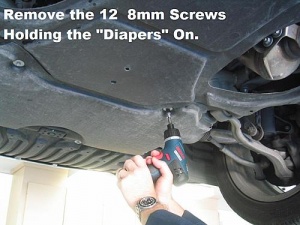
Layout plastic drop sheets under trans pan and under trans cooler intermediate connector.
Find suitable containers for catching and storing at least 10L of waste fluid.
Have a pen and paper ready to record quantities of all removed old fluid and all replaced new fluid. Record results on print out of the suggested Table of Fluid Quantities below.
Open the in-line connector and catch the fluid
Open the intermediate in-line connector in the trans to cooler supply line (blue star in schematic) and catch the fluid.
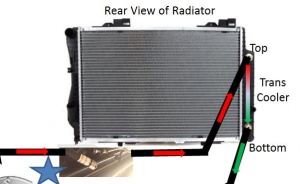
Prepare the Flushing System
Connect the Flushing System output connector to the input connector, ie create a closed system.
Have about 2L of new fluid in the Flushing System New Fluid Pressure Container.
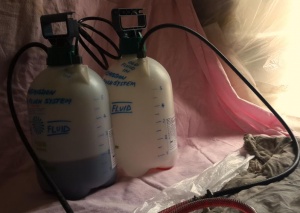
With the two Flushing System hydraulic lines connected together, prime the output line and the in-line filter of the Flushing System with new fluid using the hand pump in the New Fluid Container with any one air connection open. Stop priming when new fluid starts to enter the Old Fluid Container.) (Uses about 0.3L.)
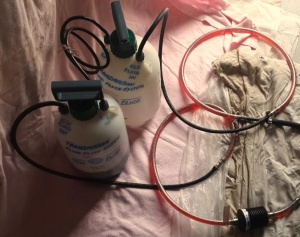
Install the flushing system in the trans to cooler supply line at the intermediate in-line connection.
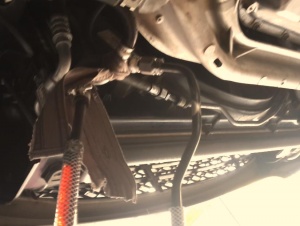
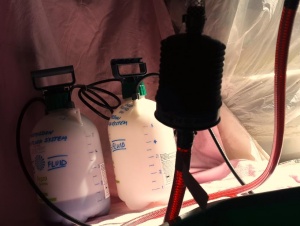
Flush trans cooler and return line
Bend over and clamp rubber inlet hose to Old Fluid container to prevent fluid going back into Trans. Then use either hand pump to pressurise both Old and New Fluid Containers. Observe the New Fluid Container level and allow 1L of new fluid to discharge into trans cooler and return line. This flushes old fluid from the trans cooler and return line into the trans pan and ensures that the cooler and the return line contain nice clean fluid before starting the draining or flushing procedure.
Notice the dark colour of the discharged old fluid in the next Figure.
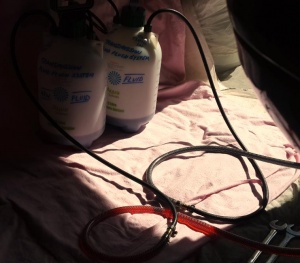
Record the fluid levels in the Flushing System New Fluid Container and the Old Fluid Container.
Remove Wiring Brace
Remove the wiring brace for the O2 sensors running across the front part of the transmission pan. Then unclip the connectors from the bracket holding them in place, and tuck the wiring and connectors up out of the way.
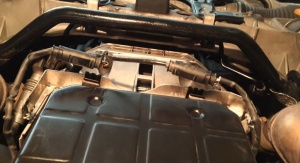
Record Location of Pan Bolts and Sprags
TAKE A PHOTO and then carefully check the position and location of the pan bolts and sprags before removing them. (Front right corner has odd sprag with threaded bolt hole.)
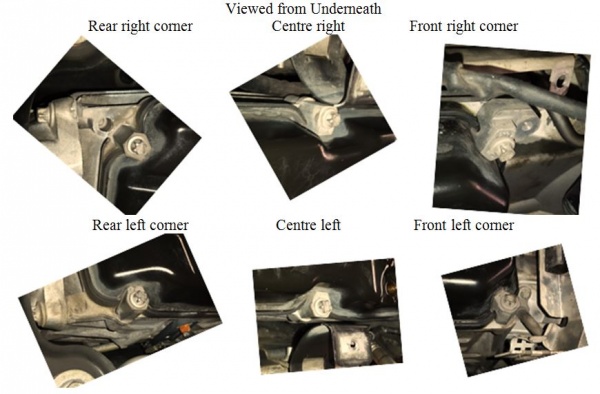
Drain Transmission Fluid
Place a waste container under the transmission drain plug, and remove the drain plug with a 6mm Hex socket and ratchet. Around a litre or so of fluid will drain from the pan. Note the 6mm Hex drain is easy to damage unless a steady upward force is applied during removal.
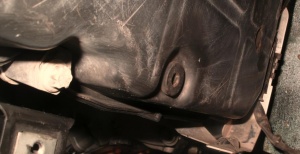
Carefully collect all Transmission Fluid drained to be measured later.
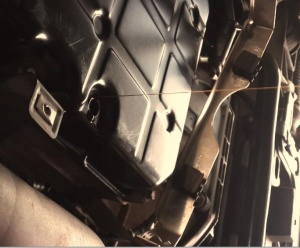
Using the MB drift or other suitable tool, pry the transmission overflow pipe off its seat in the pan by inserting the drift through the drain plug hole in the transmission pan. About another 2 - 3 litres of fluid will drain out. The overflow pipe doesn’t need to come completely off its seat. Just dislodged enough so the rest of the transmission fluid will drain out.
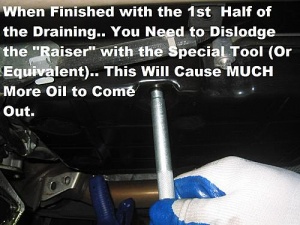
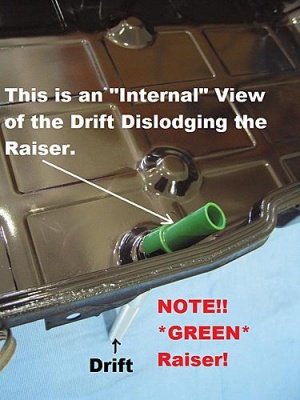
Carefully collect all Transmission Fluid drained to be measured later.
Temporarily Reinstall the Old Drain Pan Plug Finger Tight to Stop Drips
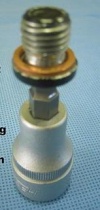
Remove the three E10 torx bolts and sprags holding on the transmission oil pan on the right side. Loosen the three E10 torx bolts and sprags on the left side. Carefully pull down on a corner of the pan to release the pan from the transmission. Keep pan level.
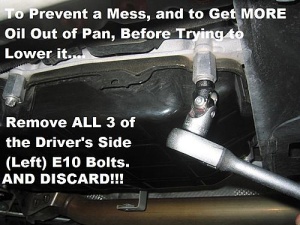
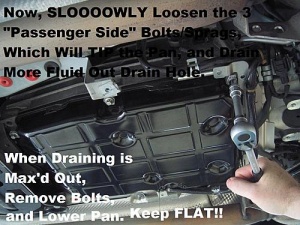
Carefully collect all Transmission Fluid drained to be measured later.
Remove the Transmission Filter
Grab the transmission filter and pull straight down to remove from transmission.
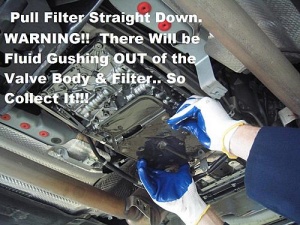
Carefully collect all Transmission Fluid drained to be measured later.
Record the quantity of fluid after the pan/filter removal
Record the quantity of fluid collected during the pan and filter removal process.
Remove white overflow pipe and magnets from inside trans pan
TAKE A PHOTO and then remove the white standoff pipe and the two magnets that sit on the bevelled edge of the trans pan.
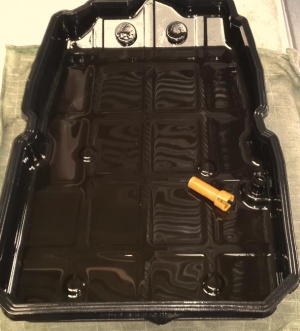
Clean Transmission Pan and Mating Surfaces
Remove and discard the transmission pan gasket.
Now the most important part, cleaning. Thoroughly clean the transmission pan, magnets, sprags, and pan mounting surface of the transmission. The sealing surfaces of the pan and transmission housing must be absolutely free of any contaminates. Use a quick flashing solvent to clean everything, like Brake Parts Cleaner, Isopropyl Alcohol, Denatured Alcohol, etc. For good measure if you have compressed air, blow off the pan to make sure no lint, etc is left behind.
I cleaned the NEW pan, NEW gasket, and transmission housing with a new microfiber cloth. Tried the leather chamois, and it left a bunch of lint behind. So, after cleaning with the microfiber I blew everything off with compressed air.
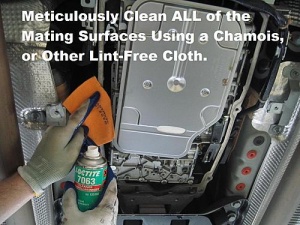
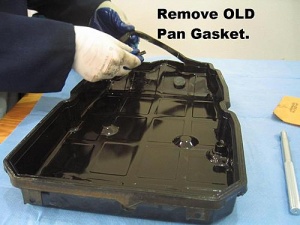
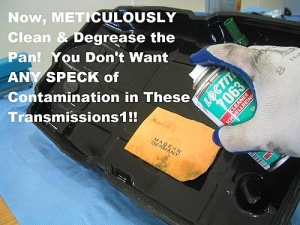
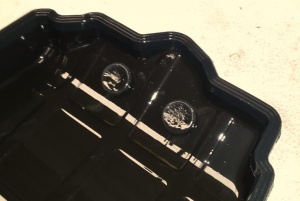
Install New Transmission Filter
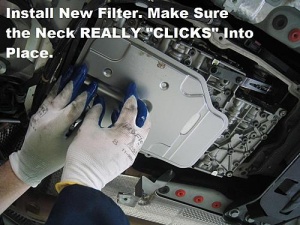
Reinstall Cleaned Transmission Pan
Note need to replace the cleaned magnets back into the bevelled side of the pan in the same way you removed them.
Place a NEW overflow tube onto the inside of the pan above the drain plug hole. Be certain the tube firmly snaps into place and the bottom of it is sitting flush on the pan. Notice a Definite CLICK.
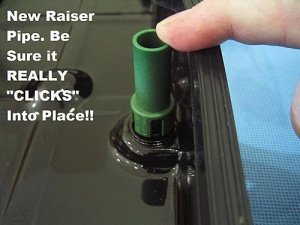
Place a NEW transmission pan gasket onto the pan. CAUTION: Do not apply any sealant or sealing compound to transmission oil pan or transmission housing.
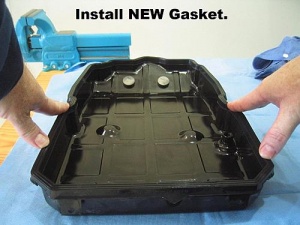
Have the six NEW transmission bolts and the sprags ready, then hold the transmission pan in place, while inserting bolts through each sprag and hand tighten the bolts.
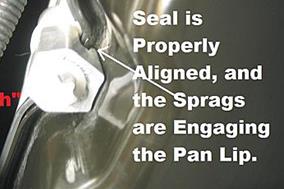
I then proceeded to bolt up the pan. Here is where I think I screwed up last time. There were 2 sprags, that weren't quite touching the transmission housing on the outside edge before I pulled the pan. This time I was VERY careful in making sure all the sprags were correctly seated on the pan. I did this by putting the two centre sprags and bolts on loose enough just to hold the pan in place. Then I had to wiggle and push the pan toward the rear of the car to get the pan and sprags to seat correctly. The rear of the pan gasket touches the bracket for the transmission mount, and the gasket needs to be compressed slightly against it. I noticed this the first time I put the pan up, but didn't push the pan toward the rear while putting the sprags and bolts in, and remember the front two were a little difficult to hand tighten the bolts. By pushing the pan toward the rear while hand tightening the bolts seemed to work much better this time.
Can use automotive high tensile M6 x 1.0 x 40 45mm hex key bolts torqued to 12Nm (8.9ft-lbf) as a temporary measure.
Once there are no leaks then the M6 bolts can be replaced with the genuine MB one-use ones.
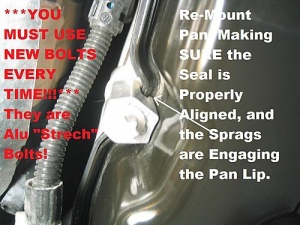
Now using a torque wrench tighten the six bolts to 4Nm. Once all are tightened to 4Nm (3 ft-lbf), then tighten each bolt an additional 180°.
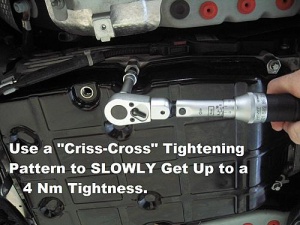
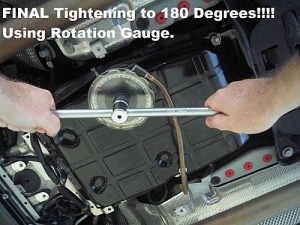
Reinstall the electrical connectors
Reinstall the electrical connectors back into place on the bracket in front of the trans pan and reconnect them.
Record Volume of Fluid Drained from Pan
Record the volume of fluid drained from pan.
Calculate the total quantity of fluid drained so far
Calculate the total quantity of fluid obtained from the system so far using the printed record table. Take into account that a small quantity may have been put back in during the initial flushing of the return line.
Expect about 4L (4.2 US Quarts) total so far.
Initial Filling Transmission with Fluid
Fill the Assenmacher Refill Container with new fluid to the quantity removed from the calculation above.
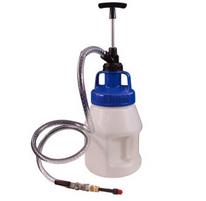
Attach the Assenmacher Refill adapter (ATF 129) shut-off valve and hose to the pan.
Technique for Filling
The most important part is to always pump fluid in and try to pump as little air in the transmission as possible.
If necessary search for the latest up to date MB WIS document AR27.00-P-0270SYZ on filling the transmission and checking fluid level.
Pump in initial quantity of fluid into the transmission pan.
Shut off valve and leave the adapter, pump, and bottle in place. (The trans should now have its original quantity of fluid but as a mixture of new fluid in pan and old fluid in torque converter.)
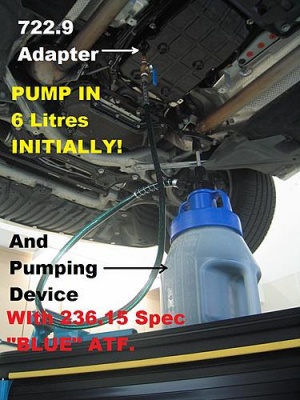
Flushing Torque Converter and Cooler
Transfer attention back to the Flushing System. Make sure Flushing System New Fluid Container contains at least 4L of new fluid. Record any fluid quantity changes.
Start the vehicle engine and observe the discharge of old fluid into the Flushing System Old/Dirty Fluid Container. The discharge rate will be approximately 1L per 15 secs. Do not let the Flushing System New Fluid Container run empty. If necessary shut off the engine to add a pause in the flushing process.
When convenient place foot on brake and shift through "P-R-N-D" several times.
When the colour of the discharge fluid appears clean or when the 4L of new fluid is nearly all consumed, stop the engine.
Record any fluid quantity changes.
It may be necessary to add more clean fluid and repeat until the discharged fluid is clean. This is where I add the genuine M-B fluid. Record any fluid quantity changes.
The trans pan, torque converter and cooler should now contain close to 100% new fluid.
Remove the flushing system.
Setting Transmission Fluid Level
Have new pan drain plug and washer ready for final installation. The seal ring for the drain plug must be replaced. The ring is a 12mm x 16mm x 1.5mm ring. Any standard copper 12mm sealing ring can be used. These can be had at most hardware stores. If you plan on doing a few changes, pick up the 25pack from McMaster Carr.

Connect charger to car battery or charging point
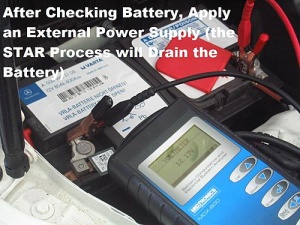
Activate STAR SDS and navigate to monitor transmission fluid temperature. (ECU/Electronic transmission control (722.9 7G-Tronic)/Actual values/Oil level check/F2/010 Transmission oil temperature.)
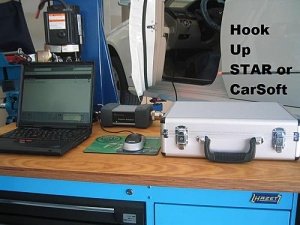
Restart car engine and allow to idle in Park.
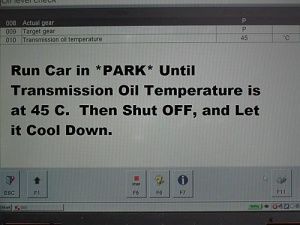
Shut off engine when fluid reaches 45°C.
Pump in remaining fluid to make a total of 9.5L. Record any fluid quantity changes.
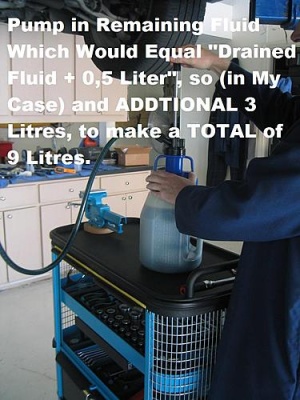
Leave filler adapter in place.
Start the engine. DO NOT SHUT OFF THE ENGINE UNTIL INSTRUCTED TO BELOW, ie only when fluid level is correct as below.
With the engine idling and your foot on the brake, shift through "P-R-N-D" several times.

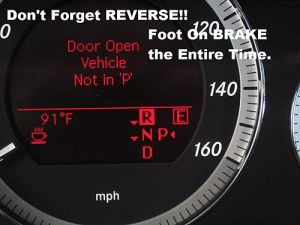
Allow engine to idle in selector lever position "P". ie keep the engine running.
Call up the transmission fluid temperature Transmission oil temperature using STAR DIAGNOSIS.
While watching the transmission temperature via STAR, wait until the temp reaches just under 45°C/113°F.
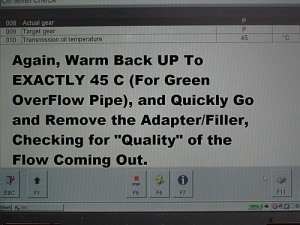
The engine must run at idle speed and the transmission oil temperature must not be above the specified transmission oil temperature as too much transmission oil is drained at a higher transmission oil temperature.
Quickly get under the car and remove the filler adapter and allow the excess fluid to drain out until a small quantity still drains out. Make sure the temp is 45°C/113°F exactly not over or under. Keep checking the temperature and make sure the flow is correct when the temperature is exactly 45°C (exactly and not over or under).
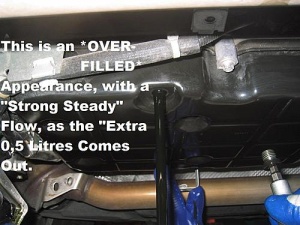
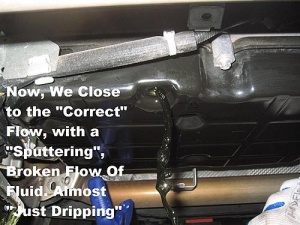
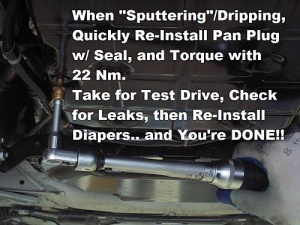
Shut off the engine.
If the fluid flow is not constant after opening the filler adapter, the transmission fluid level has to be corrected and then adjusted again, ie pump in more transmission fluid using the fluid dispenser and the filler adapter. Then retest the level at exactly 45°C as before.
The transmission is now at the correct level.
Final Steps
Clean any excess fluid off of pan and drain plug.
Reinstall the engine covers you removed.
Printable Summary of Method Using DIY Flushing System and Fluid Quantities
- 1. Shift trans selector in Neutral with ignition off.
- 2. Get the car raised with the trans pan level.
- 3. Remove the engine splash panel.
- 4. Layout plastic drop sheets under trans pan and intermediate connector.
- 5. Find suitable containers for catching and storing at least 10L of waste fluid.
- 6. Have a pen and paper ready to record all fluid removed/replaced quantities.
- 7. Open the trans to cooler supply line at the intermediate in-line connector and catch the fluid. (Expect about 0.02L.)
- 8. Add 2L of new fluid into Flushing System New Fluid Pressure Container.
- 9. With the two Flushing System hydraulic lines connected together, prime output line and in-line filter of flushing system with new fluid using hand pump in the New Fluid Container with any one air connection open. (Uses about 0.3L.)
- 10. Install the flushing system in the trans to cooler supply line.
- 11. Bend over and clamp rubber inlet hose to Old Fluid container to prevent fluid going back into Trans. Use either Flushing System hand pump to pressurise both Old and New Fluid Containers. Observe the New Fluid Container level and allow 1L of new fluid to discharge into trans cooler and return line. This flushes old fluid from the trans cooler and return line into the trans pan.
- 12. Remove the wiring brace at the front of the trans pan and tuck the cables out of the way.
- 13. TAKE A PHOTO and carefully check the position and location of the pan bolts and sprags. (Front right corner has odd sprag with threaded bolt hole.)
- 14. Remove the trans drain plug and catch the fluid. (Keep steady upward force on 6mm hex socket.) (Expect only a few drops of fluid.)
- 15. Dislodge the trans overflow tube and catch the fluid. (Expect about 2 – 3L.)
- 16. Remove three pan bolts on right side.
- 17. Remove the three bolts on left side and catch the fluid. Keep pan level. (Expect about 1 - 2L.)
- 18. Remove the Transmission Filter and catch the old fluid. (Expect about 1 - 2L.)
- 19. Record the quantity of fluid collected during the pan and filter removal process.
- 20. TAKE A PHOTO and then remove white overflow pipe and magnets from inside trans pan.
- 21. Clean pan, and magnets.
- 22. Clean trans gasket seat.
- 23. Install new filter. Listen for definite CLICK.
- 24. Reinstall magnets.
- 25. Install new white overflow tube. Notice a definite CLICK.
- 26. Install new pan gasket on cleaned pan.
- 27. Have six NEW transmission bolts and sprags ready.
- 28. Reinstall pan and while pushing the pan toward the rear, hand tighten bolts.
- 29. Torque each bolt in a cross pattern in stages to 4Nm (3 ft-lbf), then tighten each bolt an additional 180°.
- 30. Reinstall the electrical connectors at front of pan. (Tucked away they touch the exhaust.)
- 31. Calculate the quantity of oil removed so far. Will be about 7L.
- 32. Fill Assenmacher Refill Container with 5L new fluid. Record any fluid quantity changes.
- 33. Attach adapter to pan.
- 34. Using Assenmacher pump in the initial quantity of fluid into the transmission pan. (The trans should now have its original quantity of fluid but as a mixture of new fluid in pan and old fluid in torque converter.)
- 35. Shut off valve and leave the Assenmacher adapter, pump, and re-fill container in place.
- 36. Make sure Flushing System New Fluid Container contains about 4L of new fluid. Record any fluid quantity changes.
- 37. Use either hand pump to provide some initial pressure in both Old and New Fluid Containers. (Watch the level of the New Fluid Container as a guide as to how much pressure to add, ie pressurise until the level just starts to reduce.)
- 38. Flush Torque converter. Start engine and observe discharge of old fluid into the flushing system.
- 39. If necessary shut off engine to add a pause in the process.
- 40. When convenient place foot on brake and shift through "P-R-N-D" several times.
- 41. When the colour of discharge fluid appears clean or when the 4L of old fluid is discharged and 4L of new fluid is consumed, stop engine.
- 42. It may be necessary to add more clean fluid and repeat until discharged fluid is clean. Record any fluid quantity changes.
- 43. The trans pan, torque converter and cooler should now contain close to 100% new fluid.
- 44. Remove the flushing system.
- 45. Have pan drain plug and new crush washer ready for final installation.
- 46. Connect charger to car battery or charging point.
- 47. Connect STAR Diagnosis Assistance System to OBDII connector.
- 48. Using STAR, monitor trans fluid temperature. (ECU/Electronic transmission control (722.9 7G-Tronic)/Actual values/Oil level check/F2/010 Transmission oil temperature.)
- 49. Restart car engine and allow to idle in Park.
- 50. Shut off engine when fluid reaches 45°C.
- 51. Using Assenmacher pump in remaining fluid to make a total of 9.5L. Record any fluid quantity changes.
- 52. Leave filler adapter in place and allow transmission to cool down to say 40°C.
- 53. Final Fluid Level Setting. Start the engine. DO NOT SHUT OFF THE ENGINE UNTIL INSTRUCTED TO BELOW, ie only when fluid level is correct as below.
- 54. With engine idling and foot on brake, shift through "P-R-N-D" several times.
- 55. When the fluid temperature just reaches exactly 45°C remove the adapter filler.
- 56. Observe the quality of the fluid discharging from the drain plug aperture.
- 57. When only a small quantity of fluid dribbles out, reinstall the pan drain plug with a new crush washer. Torque drain pan plug to 22Nm (16.5 ft-lbf).
- 58. Shut off the engine.
- 59. The transmission fluid is now at the correct level.
- 60. If no fluid was discharged when the trans fluid temp reached the 45°C mark (with engine idling and transmission in Park), then add more fluid and repeat the last few steps.
- 61. Measure quantity of fluid that dribbled out during level setting.
- 62. Clean any excess fluid off of pan and drain plug and reinstall underskirts etc.
Printable Summary of Table of Fluid Quantities Used
The numbers in the following table refer to the section Printable Summary of Method Using DIY Flushing System and Fluid Quantities
| Action | Qty in Assenmacher Refill Container [L] | Qty in Flushing System New Fluid Container [L] | Qty in Flushing System Old Fluid Container [L] | Actual Qty Into Transmission [+ In L] | Actual Qty Out-of Transmission [- Out L] | Estimated Transmission Total Qty [L] |
|---|---|---|---|---|---|---|
| 0. At Start | ||||||
| 7. Open the trans to cooler supply line at the intermediate in-line connector and catch the fluid. | ||||||
| 8. Add 2L of new fluid into Flushing System New Fluid Pressure Container. | ||||||
| 9. Prime output line and in-line filter of flushing system with new fluid using hand pump in the New Fluid Container | ||||||
| 11. … flushes old fluid from the trans cooler and return line into the trans pan | ||||||
| 11. … flushes old fluid from the trans cooler and return line into the trans pan |
| Action | Qty in Assenmacher Refill Container [L] | Qty in Flushing System New Fluid Container [L] | Qty in Flushing System Old Fluid Container [L] | Actual Qty Into Transmission [+ In L] | Actual Qty Out-of Transmission [- Out L] | Estimated Transmission Total Qty [L] |
|---|---|---|---|---|---|---|
| 14. Remove the trans drain plug and catch the fluid. | ||||||
| 15. Dislodge the trans overflow tube and catch the fluid. | ||||||
| 18. Remove the Transmission Filter and catch the old fluid. | ||||||
| 32. Fill Assenmacher Refill Container with 5L new fluid. | ||||||
| 34. Using Assenmacher pump in the initial quantity of fluid into the transmission pan. |
| Action | Qty in Assenmacher Refill Container [L] | Qty in Flushing System New Fluid Container [L] | Qty in Flushing System Old Fluid Container [L] | Actual Qty Into Transmission [+ In L] | Actual Qty Out-of Transmission [- Out L] | Estimated Transmission Total Qty [L] |
|---|---|---|---|---|---|---|
| 36. Make sure Flushing System New Fluid Container contains about 3L of new fluid. | ||||||
| 38. Flush Torque converter. Start engine and observe discharge of old fluid into the flushing system. | ||||||
| 42. It may be necessary to add more clean fluid and repeat until discharged fluid is clean. | ||||||
| 44. Remove the flushing system. |
| Action | Qty in Assenmacher Refill Container [L] | Qty in Flushing System New Fluid Container [L] | Qty in Flushing System Old Fluid Container [L] | Actual Qty Into Transmission [+ In L] | Actual Qty Out-of Transmission [- Out L] | Estimated Transmission Total Qty [L] |
|---|---|---|---|---|---|---|
| 51. Using Assenmacher pump n remaining fluid to make a total of 9.5L. | ||||||
| 53. Final Fluid Level Setting. After stopping the engine. | ||||||
| 53. Final Fluid Level Setting. After stopping the engine. | ||||||
| 59. The transmission fluid is now at the correct level. | ||||||
| 61. Measure quantity of fluid that dribbled out during level setting. | ||||||
| 100. At end. |